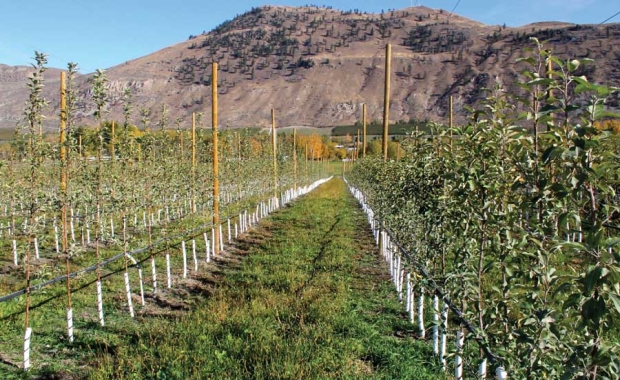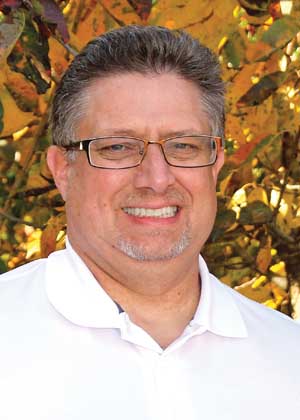
A first-leaf planting of SugarBee apples is on the left and Gala on the right. Sam Godwin planted the SugarBees 18 inches apart with 10 feet between rows, hoping for mature yields of at least 80 bins per acre. (Geraldine Warner/Good Fruit Grower)
The number of apple growers in Washington has shrunk from more than 5,000 to fewer than 1,500 today through a process of consolidation.
But Sam Godwin, who farms 200 acres of orchard in Tonasket in north central Washington, believes there’s still a place for small growers because they have some advantages over the mega operations.
One is the ability to be an early adopter.
Growers trying to accomplish something on the scale of 1,000 acres have to rely much more on people, teams, and processes, Godwin says, whereas the small grower is personally involved.

Sam Godwin
“The advantage I have is I can be more nimble and quick,” he said. “By being involved and adopting things sooner, maybe I can extract a premium because I can stay one step ahead of the machine.”
Another advantage is that he has a small team of experienced year-round employees who’ve been working for him for ten years. He also hires 24 H-2A guest workers who return year after year and don’t need to be retrained.
The ability to survive as a small farmer is important to Godwin, who grew up on his family’s small orchard in Tonasket and hopes his 10-year-old son, Lukes, will carry on the family legacy.
Godwin knew from a young age that he wanted to be an orchardist, but his career took a different path at first.
He graduated from high school in 1981 and went to Washington State University to study horticulture, but since the economic outlook for fruit growing was not promising at the time, he decided to study engineering instead.
After graduating, he got a job as an engineer at The Boeing Company in Seattle, Washington, and worked his way into management, earning a master’s degree in business administration from Seattle University in his spare time.
Still, he yearned to return to his roots some day and attended the annual Hort meeting to keep in touch with the industry.
“I thought I would work at Boeing until retirement age and then I could come back and farm until all the money I made in the city was gone,” he quipped.
But after the September 11 terrorist attacks in 2001, Boeing began to downsize its senior management. Godwin suddenly had the opportunity to take early retirement at the age of 39 and realize his dream of being an orchardist and living in the small community where he grew up.
He and his wife, Gwynne, returned to Tonasket with their two daughters and began a process of buying and leasing orchards. The years 1998 to 2000 had been a tough period for apple growers, particularly for those with Red Delicious.
“It was a down cycle,” Godwin said, “So when I came back there were a lot of distressed farms and property for sale at discounted prices. That’s part of the reason I was able to buy back in when I did.”
Their first orchard was 25 acres of Red and Golden Delicious. Godwin immediately began replacing the Red Delicious with cherries, which would come into production faster than apples and generate money to renovate the rest of the orchard with more profitable varieties.
He and his wife did most of the work, including harvest, with the help of one other person. “It was one of those sweat-equity deals,” he recalled.
“We wanted to start small and try to stay solvent because of the ups and downs of the industry, so we’ve expanded, but very cautiously. That’s the way we’ve approached all of our projects as we’ve taken them on. When we do our analysis, the farm has to pay for itself and pay for future expansion.”
But opportunities for expansion in Tonasket are limited. Okanogan County used to be a major apple-growing region, but production has shifted farther south over the past few decades.
There are no big tracts of land with water available, so the Godwins had to acquire acreage in small pieces and now farm at six locations in the area.
They own 106 acres and lease 20 acres. In addition, Godwin and his brother Allen, who is a field horticulturist for Chelan Fruit Cooperative, jointly own Box Canyon Orchard, which their parents, Calvin and Jean Godwin, ran until they retired last year.
Godwin thinks it’s still possible to make a living on a 100-acre farm, but it needs to have the right varieties and planting systems. “I would not want to do it on a hundred acres of Reds,” he said.
Portfolio
Honeycrisp was one of the first varieties he planted when he bought his orchard.
He still thinks there’s a good future for the variety, despite increasing volumes, but he’s also planting new managed varieties in order to diversify and obtain an advantage.
They include SugarBee, a variety produced exclusively by members of Chelan Fruit Cooperative, where he takes his fruit. (Read “SugarBee causes a buzz”)
He looks at his farm as an investment portfolio.
Pears are his bonds: They don’t make a huge amount of money, but they always make something.
Cherries are the high-risk stock: Some years can be very good but there’s always the chance of a lost crop, and he’d be nervous about planting too many.
Apples are the middle ground. All of his apples are organic, as are some of his cherries and pears.
Although he’ll continue to expand if the opportunities arise, his focus is not on farming more acres but on expanding production on current acreage and increasing yields, which he sees as market insurance.
“If I have a five-acre block and I pick 50 bins to the acre and I have a neighbor who has a five-acre block and he picks 100 bins per acre, he can sell his fruit for half the price and make the same amount of money,” he explained.
“And I think that’s exactly what’s happening to us in Okanogan County,” he said. “We have a lot of old, traditional orchard with 30 to 50 bins per acre and you go to the Columbia Basin and everyone’s growing 60 to 80 bins, so they can sell for a third to a half as much and make the same amount of money.
“While in the down years it might be hard for them, it’s devastating to someone who has half the volume, so we want to increase our yields.”
Godwin is planning on at least 80 bins an acre and is hoping for 100. In his latest plantings, trees are as close as 18 inches apart with ten feet between rows for a total of almost 3,000 trees per acre.
He has older blocks with rows 12 feet apart but said going two feet narrower makes a big difference in terms of yield potential. “It takes you from 65 to 70 bins per acre to 90 or 100.”
Godwin takes a methodical and analytical approach to fruit growing. He figures out the target number of apples per tree and bins per acre so he knows where the threshold of profitability is for the level of investment.
“There’s always some elements of chance,” he said, “But we know, going in, what we need to do to perform.
So if a tree’s not growing enough and not going to fill the canopy, so you’re not going to get the ultimate factory you need for growing the fruit, you can start figuring out why.”
Technology
As well as boosting yields, he hopes his new high-density orchards will lend themselves to robotic harvesting, which he believes is less than five years away.
He’s an early adopter of new technology and is testing an electronic trap for pests and a fire blight model and temperature monitoring network that sends alerts to his cell phone.
In his spare time, and particularly in the off season, Godwin leverages his engineering experience by working as chief information officer for Chelan Fresh Marketing, which represents Chelan Fruit, Gebbers Farms, Apple House, Gold Digger, and Jackass Mountain Ranch.
He heads the IT team that implemented a new inventory system to coordinate how inventory and other information flows between the various packers. He also evaluates new technology.
In addition, Godwin devotes time to industry activities. He has served on the Washington Tree Fruit Research Commission for the past two years and was a member of the Washington Growers Clearing House board for ten years until the association merged into the Washington State Tree Fruit Association last year.
He represented the association during the transition and is a board member of the new association.
“In the whole consolidation process with the Clearing House, there was the concern that came up time and time again: Are the big guys going to take over?” he said. “I think the structure is there so that if small guys want to be involved, they can. We designed it that way and that’s why I’m taking my turn.
“If I wasn’t willing to invest time and energy into it, what would I expect for my son and the next generation?” he asked. “I want to do my best to represent the smaller grower in a less favorable area so maybe there’s a future.”
It also helps him understand the broader issues.
“Whether you’re working at a Fortune 100 company like Boeing, a big conglomerate like Gebbers Farms, Rainier Fruit, or Stemilt, or on my little farm, we’re all facing the same challenges and issues—global politics and currency valuations and all those things that are going on that decide who can afford to buy our product,” he said.
Consolidation
Godwin thinks further industry consolidation is inevitable, partly because new technology, such as robots, will require a certain economy of scale.
But he is convinced there will be a place for the small grower, though it may mean having 250 acres of the right orchard instead of 100.
“The way the economy and everything looks now, we’re probably in for another few years of tumultuous ups and downs, depending on the crop year, which means it’s even more important to choose wisely when you’re doing these big investments,” he said. “It’s going to continue to put pressure on people who aren’t willing to innovate and take that step forward.”
“Fruit growing is still a great lifestyle,” he added, “But it’s more business than ever.” •
-by Geraldine Warner






Leave A Comment